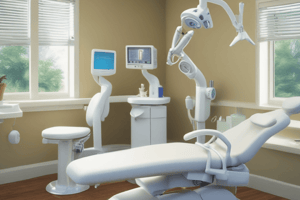Podcast
Questions and Answers
What is a common physical examination finding in obstructive jaundice?
What is a common physical examination finding in obstructive jaundice?
- Dark-colored urine (correct)
- Tenderness in the liver
- Enlarged spleen
- Xanthomas
Which type of jaundice is characterized by pale or clay-colored stools?
Which type of jaundice is characterized by pale or clay-colored stools?
- Physiological jaundice
- Obstructive jaundice (correct)
- Congenital hyperbilirubinaemia
- Haemolytic jaundice
What symptom is typically absent in haemolytic jaundice?
What symptom is typically absent in haemolytic jaundice?
- Dark-colored urine
- Pruritus (correct)
- Spleen enlargement
- Liver enlargement
Which feature is most indicative of chronic liver disease associated with jaundice?
Which feature is most indicative of chronic liver disease associated with jaundice?
In which condition would you expect the presence of Kayser-Fleischer rings?
In which condition would you expect the presence of Kayser-Fleischer rings?
What is the presumptive diagnosis for a patient with painless progressive jaundice and a palpable gallbladder?
What is the presumptive diagnosis for a patient with painless progressive jaundice and a palpable gallbladder?
What type of jaundice is characterized by dark urine and dark stools, and often includes splenomegaly?
What type of jaundice is characterized by dark urine and dark stools, and often includes splenomegaly?
Which diagnostic feature would suggest acute hepatitis rather than chronic liver disease in a jaundiced patient?
Which diagnostic feature would suggest acute hepatitis rather than chronic liver disease in a jaundiced patient?
Which finding is least likely to be associated with congenital hyperbilirubinaemia?
Which finding is least likely to be associated with congenital hyperbilirubinaemia?
Which symptoms should be noted in the clinical history of a patient with jaundice for inflammatory disease evaluation?
Which symptoms should be noted in the clinical history of a patient with jaundice for inflammatory disease evaluation?
Flashcards are hidden until you start studying
Study Notes
Clinical Evaluation of Jaundice
- Jaundice is characterized by yellowing of the skin and eyes due to the buildup of bilirubin in the blood.
- Clinical evaluation of jaundice is crucial to pinpoint the underlying cause and determine appropriate treatment.
Clinical Features of Jaundice
- Fever, abdominal pain, jaundice, and tenderness suggest acute viral or drug-induced hepatitis or a hepatic abscess.
- Jaundice in the context of α-hemolysis, intravenous drug abuse, and male gender points towards acute hepatitis B or C.
- Jaundice with hepatosplenomegaly indicates chronic active hepatitis if the duration of illness exceeds 6 months.
- Abdominal pain with fluctuating jaundice is characteristic of hemolytic jaundice.
- Painless progressive jaundice with a palpable gallbladder suggests a bile duct stone, stricture, or pancreatitis.
- Jaundice, ascites, cholecystitis are indicative of cholestatic (obstructive) jaundice.
- Jaundice, ascites, and signs of chronic liver disease are consistent with liver cirrhosis.
- Jaundice, ascites, tenderness, and a painful spleen point towards pancreatic cancer.
- Jaundice and hepatic malignancy suggest either primary or secondary liver cancer.
- Jaundice with portal hypertension points towards either cirrhotic or Budd-Chiari syndrome.
- Jaundice and encephalopathy suggest hepatitis or cholestatic jaundice of pregnancy, congenital hyperbilirubinemia, or recurrent benign cholestasis.
Clinical History in Jaundice
- Duration of jaundice provides insights into the chronicity of the condition.
- Presence and character of abdominal pain, fever, and symptoms of inflammatory disease help differentiate between various causes.
- Changes in appetite, taste, weight, and habits can shed light on underlying conditions.
- History of blood transfusions, intravenous injections, sexual activity with a partner other than the wife, and alcohol use are important to exclude potential risk factors.
- Detailed drug history aids in identifying any potential medication-induced jaundice.
- Pruritus or itching is commonly associated with obstructive jaundice.
- Color of urine and stools can be indicative of various types of jaundice.
- History of pregnancy is crucial to consider, especially in cases of jaundice during pregnancy.
- Epistaxis, hepatomegaly, or bleeding tendencies can suggest liver dysfunction.
- Symptoms of encephalopathy are a sign of severe liver disease.
Physical Examination in Jaundice
- Physical examination involves assessing the following parameters:
- Anemia: Pale skin and mucous membranes can indicate hemolytic jaundice.
- Scratch marks: Pruritus can lead to visible scratch marks on the skin.
- Pulse rate: A rapid pulse rate can indicate complications like fever or dehydration.
- Hepatomegaly: Examination of the liver's size, margin, surface, tenderness, and presence of a bruit (abnormal sound) is crucial.
- Splenomegaly: An enlarged spleen can be indicative of various conditions, including hemolytic jaundice and liver cirrhosis.
- Ascites: The presence of fluid in the abdominal cavity can be a sign of liver failure.
- Signs of chronic liver disease: Examination for stigmata of chronic liver disease, such as spider angiomas, palmar erythema, and gynecomastia.
- Xanthomas and xanthalasma: These subcutaneous lipid deposits can suggest hyperlipidemia or obstructive jaundice.
- Kayser-Fleischer ring: This brown-green pigmented ring around the cornea, visible on ophthalmoscopic examination, is a characteristic feature of Wilson's disease.
Types of Jaundice
- Obstructive Jaundice:
- Characterized by green-yellow or deep-yellow skin discoloration.
- Pruritus is common due to the accumulation of bile salts.
- Dark urine and pale, clay-colored stools are characteristic.
- Abdominal pain may occur.
- Hemolytic Jaundice:
- Dark-colored urine and stools are typical due to the increased breakdown of red blood cells.
- Pruritus is usually absent.
- The liver and spleen may be enlarged.
- Congenital (Familial) Hyperbilirubinemia:
- Familial unconjugated hyperbilirubinemia:
- Includes conditions like Gilbert's syndrome and Crigler-Najjar syndrome.
- Familial conjugated hyperbilirubinemia:
- Includes conditions like Dubin-Johnson syndrome and Rotor's syndrome.
- Familial unconjugated hyperbilirubinemia:
Studying That Suits You
Use AI to generate personalized quizzes and flashcards to suit your learning preferences.




